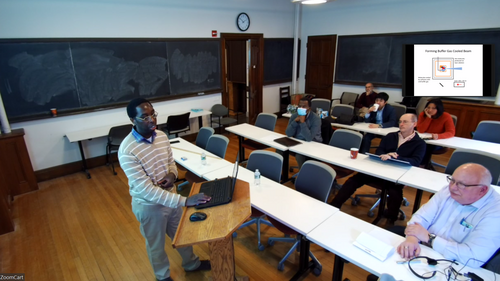
On March 10, 2023, Eustace Edwards successfully defended the thesis Cold Thallium Fluoride Beam: Buffer Gas Cooling, Beam Production, and B3 Π Excited State Hyperfine Spectra” (advisor: Steve Lamoreaux).
Edwards explains, “Beginning in the 1950s, researchers proposed using atomic systems to search for permanent electric dipole (pEDM) moments in fundamental particles (fundamental symmetry test). Thallium fluoride (TlF) was among the first proposed systems. In experiments performed at Yale in the 1980s, the Hinds group searched for a pEDM induced frequency shift in the hyperfine spectra of TlF using a thermal beam (350 K rotational temperature). As a reminder, hyperfine is due to magnetic interactions between the nuclear spins and the other angular momentum in a rotating molecule. Due to the properties of the thermal beam, detection method and other details, the experiments were only sensitive to a pEDM induced frequency shift on the order of 0.1 milli-Hertz. After these early experiments, interest in TlF waned, until recently. With the proposed laser cooling transition between hyperfine components in thallium fluoride’s ground (X) and its excited (B) state, the interest in TlF returned. Prior to this work, there was no published work on the details of the B state’s hyperfine structure, which is necessary to identify the cooling transition. This thesis work sought to create a cold slow beam of TlF, measure the B-state’s hyperfine spectra, and investigate the molecule’s hyperfine structure. To create the thermally cold beam (3.6K), we constructed a cryogenic buffer gas beam source (CBGBS). Using the CBGBS and laser spectroscopy, we characterized the beam source, recorded low temperature hyperfine spectra, discovered an unusually large hyperfine interaction (on the order of the rotational constant), observed rotational state mixing, and identified the initially proposed laser cooling transition. Using knowledge gained from this work (cold beam construction, hyperfine structure, B-state’s optical detection), researchers proposed a new TlF pEDM experiment (CeNTREX), which is proposed to reduce the observable frequency shift to be on the order of 0.01 micro-Hertz. With CeNTREX, it may be possible to achieve a factor of 10, 000 improvement over the previous experiments.”
Edwards is currently a Senior Systems Engineer at Raytheon Technologies in Woburn, MA.
Thesis Abstract: Since the idea of laser cooling on thallium fluoride’s (T1F) |X1 Σ〉 → |B3 Π〉 optical transition, there has been renewed interest TlF beams for both laser cooling and fundamental symmetry test. In particular, researchers were interested in the hyperfine structure in the lowest rotational energy levels of the B state, and the laser cooling potential of lowest Q-branch transition. In this work, we constructed and characterized a cryogenic buffer gas beam source (CBGBS) to produce a rotationally cold TlF beam (3.6K). Using the cold beam, we recorded low temperature hyperfine spectrum, and discovered the B state possesses hyperfine interaction (roughly 4 times the size of the rotational constant), which leads to rotational state mixing, and spoiling of the initially proposed laser cooling transition. Since the cold beam provided unambiguous identification of TlF’s Q branch transitions, we were able to perform preliminary transverse laser cooling on the proposed laser cooling transitions.
Please click below for a flickr album of photos taken by Sid Cahn at the celebratory reception after Eustace Edward’s defense.